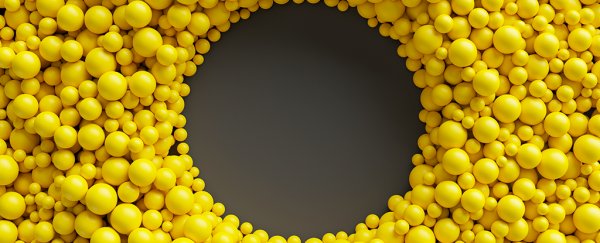Physicists have measured the sound of 'nothingness' at room temperature - an important step in our future ability to listen in to the Universe.
You can think of it a little like this - we've now been able to measure the way some of the ubiquitous 'background noise' of space interacts with our equipment, which will hopefully help us tune it out going forward.
After all, the entire Universe is crackling with the static of quantum physics, and in order to be able to pick up the faint echoes of distant astronomical giants - such as the gravitational waves rippling off a black hole merger, for example - we need to be able to tune out the quantum static.
But let's take a step back. What exactly does it mean to measure the sound of 'nothingness'?
By now most of us know that there's nothing empty about the vacuum - it's actually filled with quantum fluctuations. We can't 'hear' these fluctuations, but for the sensitive equipment scientists use to measure the minute distortions of space-time, they can create subtle effects that can be deafening.
This experiment looked at a phenomenon called quantum radiation pressure, which arises when particles interact with detectors such as LIGO - the Laser Interferometer Gravitational-Wave Observatory in the US, responsible for confirming the existence of gravitational waves a little over three years ago.
This quantum radiation pressure becomes a type of 'noise' that can interfere with results. But, like other quantum phenomena, we would usually need to study it at ultra-cold temperatures in order to keep the particles still and figure out what's going on.
But a team of researchers from Louisiana State University managed to actually measure this quantum effect in real-world conditions - at room temperature.
Which is useful because it means we may now be able to apply the findings to real-world equipment.
This experiment was done using miniature versions of LIGO - the full size ones are a pair of observatories housed almost 2,000 miles apart.
By comparing the alignment of laser beams shone over a distance, in 2015 LIGO was able to pick up minute space-quakes caused by a pair of black holes 1.3 billion light-years away swirling into one another.
A black hole merger sounds like it'd be loud, but those first waves detected warped space on a tiny, tiny scale - about 1/1,000th the diameter of a proton.
Yep, it took two objects dozens of times the mass of our Sun crashing together to make that mind-blowingly small wave.
Since then we've only gotten better at picking up the split-second distortions in spacetime caused by the intense movements of massive objects.
But despite our improvements, we're still only getting a tiny piece of the puzzle - to 'hear' a wider range of sounds in advanced versions of LIGO, we're going to need far more sensitive equipment.
"Given the imperative for more sensitive gravitational wave detectors, it is important to study the effects of quantum radiation pressure noise in a system similar to Advanced LIGO," says physicist Thomas Corbitt.
That's where the new measurements will come in handy - by being able to measure quantum radiation pressure when it arises in detectors such as LIGO, future gravitational wave detectors will be able to separate out even fainter signatures of smaller or more distant collisions.
And this is an important first step.
We might not be able to silence quantum whispering, but now that we have a better idea of what they sound like we might be able to hear what the giants are saying.
This research was published in Nature.
